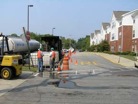Permeable Reactive Barrier (PRB) Options For Heavy Metals and Organics Remediation
Stabilization of soil and waste by chemical addition is used to reduce the leachability of metals in unsaturated settings and in groundwater. The point of application is usually the source area where spills have occurred or waste has been disposed. In some settings, however reagent application in these areas is not feasible or appropriate.
Such settings include:
- Sites where the releases occurred under industrial facilities or where redevelopment activities have placed structures over sources.
- Sites where many years of waste accumulation have resulted in such large volumes of contaminated soil and waste that stabilization costs are prohibitive
An alternative approach in these settings is to manage the leached constituents in the groundwater leaving the site such that acceptable concentrations are achieved before a point of compliance or point of exposure is reached. Permeable reactive barriers (PRBs) can be installed that allow the metal- bearing groundwater to pass through a saturated zone where emplaced reagents cause the metals to be removed from the groundwater. PRBs can be installed across the entire width of the affected groundwater if the PRBs can be installed as gates in below-ground impermeable barriers that direct the groundwater to the gates. Two examples of such gates are described in this newsletter.
Zinc Stabilization below a Development
A former industrial site had been redeveloped into an apartment complex. Surficial soil remediation was completed to meet the new land use, but groundwater remediation was deferred until after the site was redeveloped. Zinc concentrations as high as 30 mg/L below the site flowed toward a nearby creek where the discharging groundwater resulted in surface water zinc concentrations in excess of the Surface Water Quality Criteria of 2 mg/L for protection of aquatic life.
The development covered the likely zinc source areas, making source remediation infeasible. The proposed remedy was therefore to install a PRB on the downgradient side of the site to remove the zinc before the groundwater discharges to the creek.
ReSolution Partners completed a treatability study to identify reagents that would remove the zinc from the groundwater as well as be suitable for injection by direct-push technologies in the limited space available in the apartment complex. An injectable slurry was identified that lowered zinc concentrations in bench trials to ≤ 0.010 mg/L. Additional bench trials were completed in response to regulatory agency concerns regarding the longevity of the PRB. Multiple extraction procedures using site groundwater were combined with site hydrogeologic conditions to show that aqueous zinc concentrations were 0.088 mg/L after an equivalent of more than 400 years of groundwater flow through the PRB. This was considered adequate by the State regulatory agency, and ReSolution Partners completed pilot scale trials to evaluate the physical injection (e.g., reagent distribution, radius of influence).
The pilot test confirmed reagent distribution and in situ zinc concentration reductions. The full-scale PRB application included a total of 45,000 gallons of slurry injected at 63 locations over 4 weeks. Within two years the zinc concentrations in the creek met the 2 mg/L remediation goal, and the site achieved regulatory closure.




